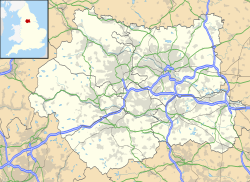| Gawthorpe | |
|---|---|
 Gawthorpe Water Tower | |
Location within West Yorkshire | |
| Metropolitan borough | |
| Metropolitan county | |
| Region | |
| Country | England |
| Sovereign state | United Kingdom |
| Post town | OSSETT |
| Postcode district | WF5 |
Gawthorpe is a village to the north of Ossett, in the Wakefield district, in the county of West Yorkshire, England. It is roughly midway between Wakefield and Dewsbury north of the A638.
Contents
The village's name derives from Gorky, a Viking name, and thorpe was a settlement, but evidence suggests the village may have Roman origins. [1] It gives its name to the Gawthorpe seam of coal, which stretches from the village down through Horbury and Crigglestone. [2]
Gawthorpe's Mayday celebrations date back to at least 1875 when a seventy-foot fir tree was bought and erected by public subscription on the village green. The maypole was last replaced in 1986. [1]
Gawthorpe Water Tower is a concrete structure built between 1922 and 1928 to store drinking water for the Ossett area. [3] The 55m tall tower is a prominent local landmark of the Ossett and Gawthorpe area. [3] [4] Since around 2006 it was no longer used for storing water, but has been used to hold communications equipment. [5] The tower received Grade II listed building status in 2020, following a campaign by residents. [4] [5]
Gawthorpe Academy On Top my mush
